You’ll elevate your craft from hobbyist to professional when you pursue beadwork design credentials, gaining mastery of advanced techniques like Herringbone and Peyote Stitch while building credibility in the competitive $5.4 billion jewelry market. These credentials validate your artistic skills, distinguish you from amateur crafters, and open doors to teaching positions, gallery representation, and custom design consultancy work. You’ll also access premium materials, professional-grade tools, and invaluable networking opportunities that’ll transform your passion into a thriving business venture with endless possibilities ahead.
Understanding Professional Beadwork Design Credentials
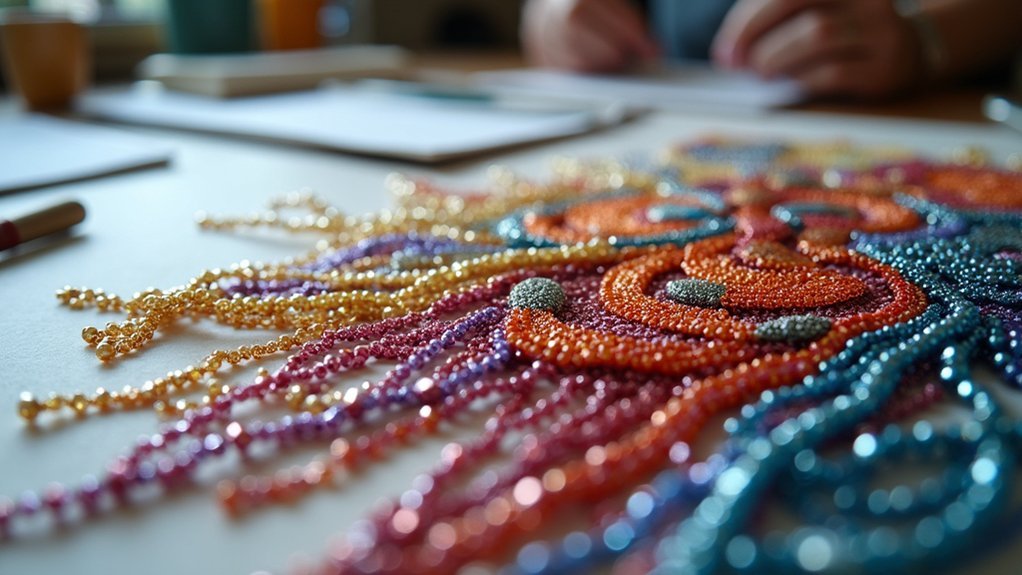
Anyone pursuing a career in beadwork design can benefit considerably from obtaining professional credentials that validate their artistic skills and technical expertise.
These credentials demonstrate your mastery of essential beading techniques including stringing, knotting, weaving, and embroidery. As a jewelry designer, you’ll showcase extensive understanding of beadwork fundamentals that clients and employers value.
Professional certification programs evaluate your technical proficiency across multiple disciplines, ensuring you’ve developed versatile skills needed in today’s competitive market.
You’ll gain credibility that distinguishes you from hobbyists and amateur crafters. The certification process requires demonstrating expertise in various methods, proving you can handle diverse project requirements.
This validation becomes particularly valuable when seeking teaching positions, gallery representation, or commissioned work where clients expect documented proof of your capabilities and artistic competence.
Enhanced Technical Mastery Through Structured Learning
While credentials validate your existing abilities, structured learning programs build the technical foundation that makes those credentials meaningful.
You’ll master extensive techniques including stringing, knotting, bead weaving, and embroidery through guided instruction. This systematic approach helps you develop the precise technique to create professional-quality pieces using advanced methods like Herringbone and Peyote Stitch.
Formal classes expose you to diverse tools and materials, enhancing your ability to select appropriate supplies for each project. Unlike learning from beading books alone, structured programs provide immediate feedback from experienced instructors and collaborative learning with peers.
Structured programs offer hands-on experience with diverse materials plus invaluable instructor feedback that books simply cannot provide.
This interactive environment accelerates your skill development and artistic growth.
Upon completion, you’ll have created a thorough portfolio showcasing various techniques and original designs, establishing essential credibility within the beadwork industry.
Building Credibility in the Jewelry Making Industry
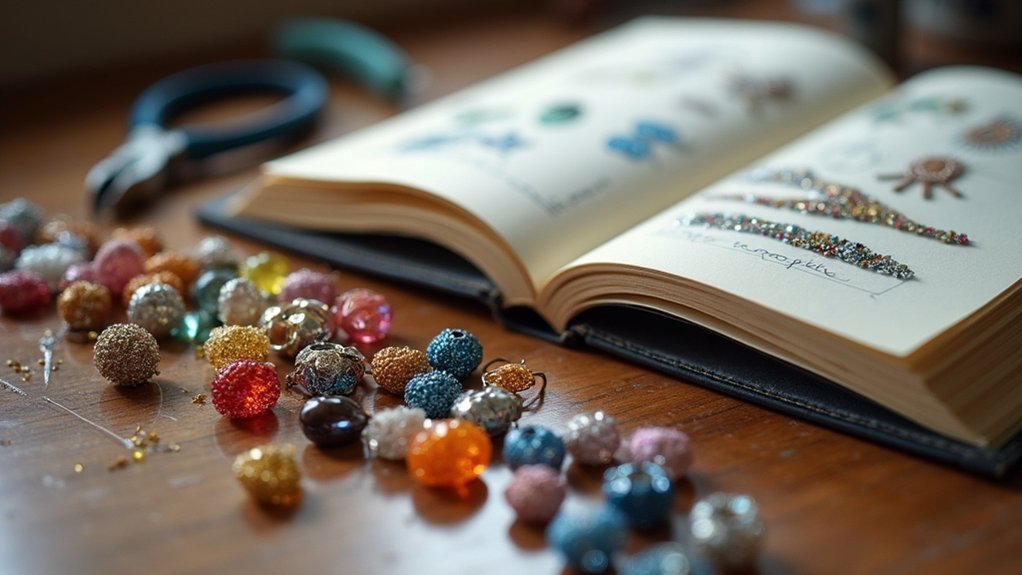
Recognition transforms your beadwork from a personal hobby into a respected professional pursuit within the $5.4 billion global jewelry industry.
When you earn professional credentials, you’re demonstrating your commitment to mastering techniques and understanding materials in this competitive field. These certifications elevate your status among peers and potential clients, directly impacting your marketability and sales.
Formal recognition through beading credentials builds essential trust with customers who want assurance they’re investing in quality pieces. They’re more likely to purchase jewelry making creations from certified designers with proven skills and knowledge.
Your credentials also open doors to teaching opportunities, allowing you to share expertise through workshops and classes while connecting with aspiring beaders in your community.
Networking Opportunities Within the Beadwork Community
You’ll discover that the beadwork community spans continents, connecting you with artists from diverse cultural backgrounds who bring unique techniques and perspectives to your craft.
Through online platforms and international organizations, you can access mentorship from master beaders who’ve spent decades perfecting their skills and building successful careers.
These connections won’t just expand your technical knowledge—they’ll also provide invaluable guidance on maneuvering the business side of beadwork design.
Global Community Connections
Because the beadwork community spans continents and cultures, building connections with fellow artisans opens doors to invaluable learning experiences and collaborative opportunities.
When you join professional beadwork organizations, you’ll gain access to a global community of talented designers who share your passion. These connections help you create innovative designs by exposing you to diverse cultural techniques and perspectives from around the world.
Online platforms revolutionize how you network, connecting bead enthusiasts globally through virtual workshops and forums.
Social media groups like Facebook’s VIB Group let you share work, receive constructive feedback, and build lasting relationships.
You’ll discover that international connections through bead shows and craft fairs provide rich cultural exchanges that enhance your artistic vision and technical skills considerably.
Professional Mentorship Access
While global connections provide broad cultural exposure, professional beadwork credentials open up something even more valuable: direct access to experienced mentors who can guide your artistic journey.
These seasoned professionals share advanced techniques and artistic concepts that aren’t available through casual online tutorials or basic workshops.
Professional mentorship access comes through specialized workshops and exclusive events where you’ll interact directly with master beadworkers.
You’ll also gain entry to private online forums where established artists provide personalized feedback and collaborate on projects.
The networking opportunities extend beyond skill development.
Your mentors can connect you with exhibition opportunities, craft show partnerships, and industry professionals who’ll elevate your artistic reputation and career prospects within the beadwork community.
Developing Your Unique Artistic Vision
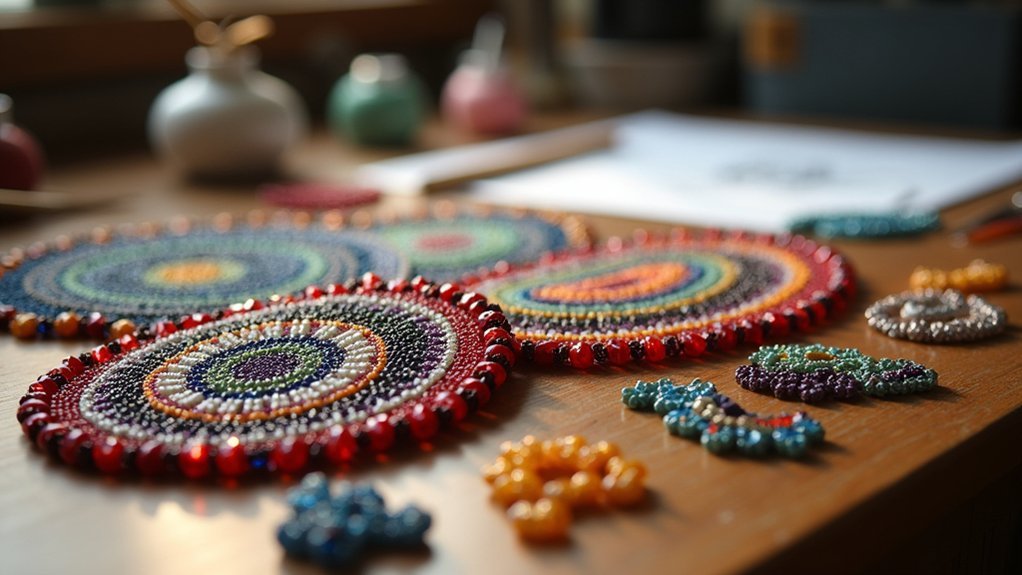
Creativity flourishes when you begin experimenting with different bead combinations, techniques, and materials to discover what truly speaks to your artistic soul.
Professional credentials provide structured guidance for mastering foundational bead stitches while encouraging personal expression in your beaded jewelry designs.
Professional training builds essential beadwork skills while nurturing your unique creative voice in jewelry making.
Classes and workshops expose you to diverse artistic approaches that’ll inspire fresh ideas and help refine your creative vision. You’ll develop technical proficiency through systematic learning while exploring cultural influences and historical techniques that add depth to your work.
Key elements for developing your artistic vision include:
- Experimenting with various materials, color palettes, and textures
- Mastering fundamental techniques like stringing, weaving, and embroidery
- Engaging with supportive artist communities for feedback and encouragement
This foundation enables you to create distinctive pieces that authentically reflect your personal style and creativity.
Market Advantages for Certified Designers
Once you’ve established your artistic foundation and unique creative voice, professional certification opens doors to significant market opportunities that can transform your beadwork from a passion into a profitable career.
In the competitive $5.4 billion global beaded jewelry market, certified designers command higher prices because credentials increase perceived value and consumer trust. Your marketability expands dramatically as galleries and boutiques prioritize showcasing certified work, providing more exhibition and sales opportunities.
Certification connects you with the broader beadwork community through exclusive networking events, advanced workshops, and collaborative projects that boost your professional visibility.
You’ll also gain access to teaching opportunities, generating additional income by sharing your expertise through classes and workshops. These market advantages position you strategically within the industry’s most profitable segments.
Access to Advanced Techniques and Materials
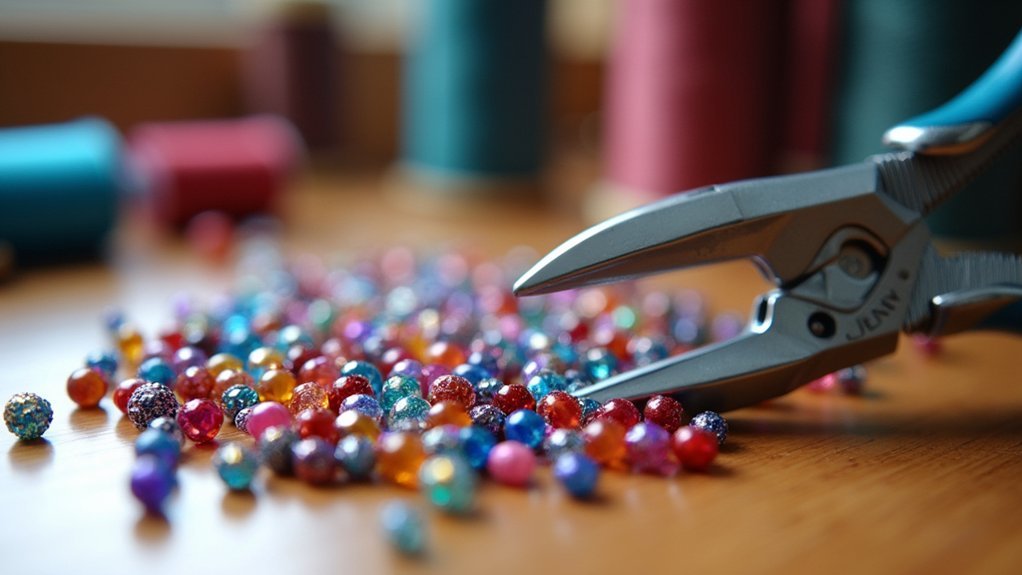
Beyond the commercial benefits of certification, you’ll access a treasure trove of sophisticated techniques that elevate your artistry far beyond basic stringing methods.
Professional programs immerse you in complex bead weaving patterns, intricate bead embroidery applications, and advanced beading wire manipulation techniques that transform your creative possibilities.
Certified courses provide hands-on experience with premium materials typically unavailable to hobbyists:
Professional certification unlocks exclusive access to premium beading materials and specialty components beyond typical hobbyist reach.
- Specialty beads including vintage Czech glass, Japanese seed beads, and precious metal components
- Professional-grade beading wire in various gauges and finishes for structural integrity
- High-quality tools like precision pliers, specialized needles, and professional looms
You’ll also gain exposure to cutting-edge industry trends and innovative methods through expert instruction.
This extensive access to advanced techniques and materials positions you to create sophisticated pieces that stand apart in today’s competitive marketplace.
Creating Professional-Grade Portfolio Pieces
You’ll need to document your technical mastery through portfolio pieces that showcase complex techniques like intricate weaving patterns, precise embroidery stitches, and sophisticated stringing methods.
Your conceptual design process should be clearly evident in each piece, demonstrating how you translate ideas into finished beadwork through thoughtful material selection and composition choices.
These elements work together to prove you can execute professional-level projects that meet industry standards and client expectations.
Technical Mastery Documentation
The cornerstone of establishing beadwork credentials lies in assembling a professional-grade portfolio that demonstrates your technical mastery across diverse techniques. Your portfolio must showcase proficiency in stringing, bead weaving, and embroidery through high-quality photographs and thorough documentation.
Each piece should include detailed descriptions of methods employed and design rationale, proving both artistic vision and technical competence.
Essential portfolio elements include:
- Original designs that reflect your unique creative voice and market differentiation
- Formal evaluation participation through programs like Master Craftsman certification for credible feedback
- Continuous updates featuring new techniques and projects to demonstrate ongoing professional development
This systematic approach to documenting your beadwork expertise creates compelling evidence of your capabilities, attracting potential clients and gallery opportunities while establishing credibility within the professional beadwork community.
Conceptual Design Process
Building a strong portfolio requires more than documentation—you need strategic pieces that showcase your artistic vision and technical range. Your conceptual design process should demonstrate mastery of at least three distinct beading methods: stringing, weaving, and embroidery.
Each piece must highlight different complexity levels and styles to prove your versatility. Drawing inspiration from different cultures enriches your artistic vocabulary and demonstrates cultural appreciation in your work.
Whether you’re exploring Native American patterns or African beadwork traditions, choose one primary stitch technique per piece to showcase clean execution. Document everything—sketches, material choices, and creative decisions.
This transparency reveals your professional approach and thoughtful process. Continuously experiment with new beads, materials, and contemporary trends to keep your portfolio fresh and demonstrate your commitment to evolving within the field.
Teaching and Workshop Opportunities
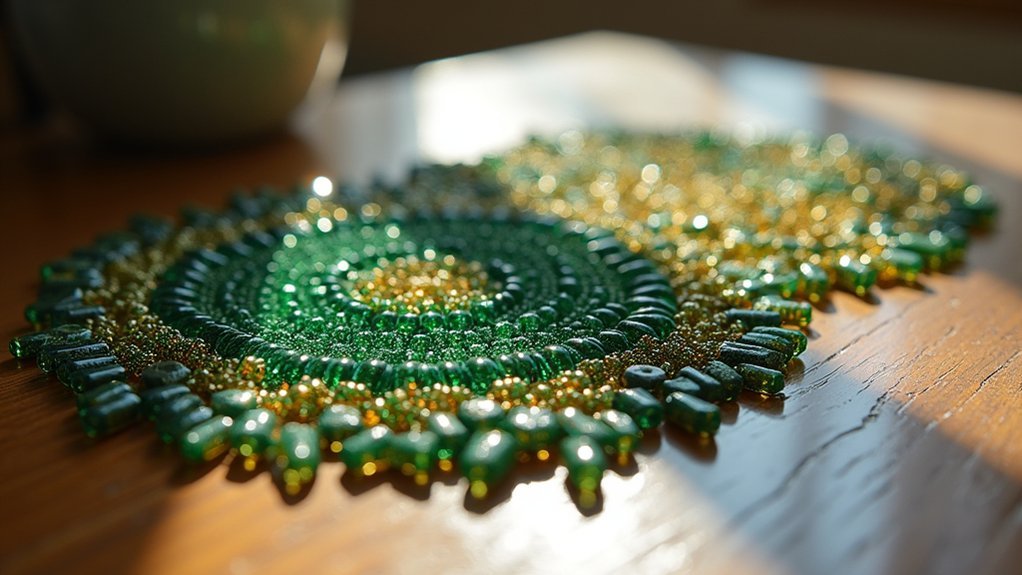
Professional beadwork credentials transform your passion into teaching opportunities that can generate substantial income while building lasting connections within the craft community.
Your credentials open doors to instructing beading classes and workshops, allowing you to share specialized techniques with enthusiastic students. Organizations actively seek qualified instructors for their programs, creating consistent income streams for credentialed professionals.
Teaching opportunities through your credentials include:
- Community workshops – Lead hands-on sessions at local craft centers and community colleges
- Private instruction – Offer personalized lessons to individual students seeking specialized techniques
- Online courses – Develop digital workshops reaching global audiences interested in beadwork design
With growing interest in beading as artistic expression, your recognized credentials boost credibility and attract students who value learning from experienced, qualified instructors in supportive educational environments.
Cultural Appreciation and Historical Knowledge
While pursuing beadwork credentials, you’ll discover that this ancient craft carries profound cultural significance spanning over 40,000 years of human artistic expression. Your historical knowledge will deepen as you explore how different bead materials and techniques reflect unique cultural identities across global communities.
| Culture | Traditional Materials | Signature Techniques | Cultural Meaning |
|---|---|---|---|
| Native American | Seed beads, shells | Loom weaving | Spiritual protection |
| African | Glass, clay beads | Strand weaving | Social status |
| European | Crystal, metal | Embroidery | Decorative art |
Through credential programs, you’ll learn essential distinctions between cultural appreciation and appropriation. This understanding guarantees you’ll practice respectfully while honoring diverse traditions. Your engagement with historical beadwork practices won’t just inspire contemporary innovations—it’ll enrich your creative process and foster genuine cultural understanding within your professional practice.
Business Development and Entrepreneurial Skills
When you earn beadwork design credentials, you’ll transform your artistic passion into a thriving business venture that taps into the $5.4 billion global beaded jewelry market.
Through formal training, you’ll develop essential entrepreneurial skills that enable effective business development, from strategic marketing and competitive pricing to efficient inventory management.
Your credentials enhance credibility in the jewelry industry, making it easier to attract clients and secure valuable partnerships.
You’ll gain access to:
- Exclusive industry events and professional networking opportunities
- Advanced e-commerce training for online sales success
- Specialized workshops connecting you with fellow professionals and potential clients
This thorough business education empowers you to optimize profit potential while building sustainable operations.
You’ll master both the artistic and commercial sides of beadwork, positioning yourself for long-term success.
Quality Standards and Industry Recognition
Beyond the commercial advantages of beadwork credentials lies their power to establish your reputation for excellence within the industry.
Professional credentials create recognized quality standards that distinguish your work from hobbyist creations. When you complete accredited programs, you’ll master diverse beading techniques and material applications that meet stringent industry requirements.
This demonstrated expertise opens doors to prestigious galleries and craft shows, elevating your artistic profile greatly.
Industry recognition through credentials connects you with established professionals, creating valuable networking opportunities for collaboration and mentorship. Your commitment to formal training signals serious dedication to craftsmanship and continuous improvement—qualities highly valued in today’s competitive market.
These credentials fundamentally validate your skills, providing tangible proof of your professional competency to clients, galleries, and fellow artisans.
Career Advancement Pathways in Jewelry Design
As you progress from completing foundational credentials to building your professional reputation, multiple career advancement pathways emerge within the jewelry design industry. Your credentials considerably boost your marketability in the competitive $5.4 billion global beaded jewelry market, opening doors to various specialized roles and entrepreneurial opportunities.
Professional beadwork credentials create pathways to:
- Teaching and workshop leadership – Share your expertise through educational programs and masterclasses
- Custom design consultancy – Work with high-end clients seeking personalized jewelry pieces
- Product development roles – Collaborate with jewelry manufacturers to create new collections
The business training component of recognized jewelry design programs equips you with essential pricing, marketing, and sales strategies. This knowledge transforms your artistic skills into a sustainable career, whether you’re pursuing gallery exhibitions, establishing an online presence, or launching your own jewelry line.
Frequently Asked Questions
Why Is Beadwork so Important?
You’ll find beadwork connects you to 40,000 years of cultural expression while providing therapeutic benefits through mindful creation. It builds community connections, develops artistic skills, and lets you craft meaningful pieces reflecting your personal style.
What Are the Objectives of Bead Making?
You’ll create unique jewelry reflecting your personal style while mastering techniques like stringing and weaving. You’re expressing creativity, connecting to cultural heritage, developing mindfulness, and building community through collaborative beadwork experiences.
What Are the Benefits of Beading?
You’ll experience enhanced creativity and relaxation through beading’s mindful motions. You’ll improve fine motor skills while expressing your artistic vision. You’ll also connect with fellow enthusiasts and potentially enter a thriving $5.4 billion market.
What Do You Call Someone Who Does Beadwork?
You’d call someone who does beadwork a bead artist or beader. If you’re specializing in specific techniques, you might use titles like bead weaver or bead embroiderer to reflect your expertise.
In Summary
You’ll find that pursuing professional beadwork design credentials opens doors you didn’t know existed. You’re not just learning techniques—you’re building a reputation, connecting with fellow artists, and developing business skills that’ll set you apart. The credibility you’ll gain gives clients confidence in your work, while the structured learning helps you master complex techniques faster. Whether you’re starting fresh or advancing your career, these credentials will elevate your artistry and professional standing.





Leave a Reply